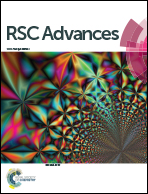Hierarchical carbon-nanotube/quartz-fiber films with gradient nanostructures for high efficiency and long service life air filters†
Abstract
Hierarchical and gradient nanostructures are important to exploit the full potential of nanofibers in filtration applications. The introduction of a gradient into carbon nanotube (CNT)/fiber hierarchical structures could result in a change of the particle capturing properties. Here, we show the fabrication of hierarchical carbon nanotube (CNT)/quartz-fiber (QF) filters with gradient nanostructures where the content of CNTs decreases exponentially along the thickness direction of the filters. The loading of catalysts for the growth of CNTs in the QF filter has been achieved using an aerosol technique, which can be carried out on a large-scale. With only 1.17 wt% CNT, the penetration of the CNT/QF filter at the most penetrating particle size (MPPS) has been reduced by one order of magnitude, while the pressure drop only increases about 6% with respect to that of the pristine QF filter, leading to an obvious higher quality factor (Qf) for the CNT/QF filter. More importantly, the service life of the CNT/QF filter with the CNT-rich side downstream has increased by 64% when compared with the pristine QF filter. In contrast, when the CNT-rich side is placed upstream, the service life of CNT/QF filter is only 41.7% of that observed when placing the CNT-rich side downstream. Scanning electron microscopy (SEM) images reveal that the gradient nanostructure of the CNT/QF filter, together with the CNT/QF hierarchical structure play very important roles in the simultaneous enhancement of the filtration efficiency and the service life of the air filters.


 Please wait while we load your content...
Please wait while we load your content...